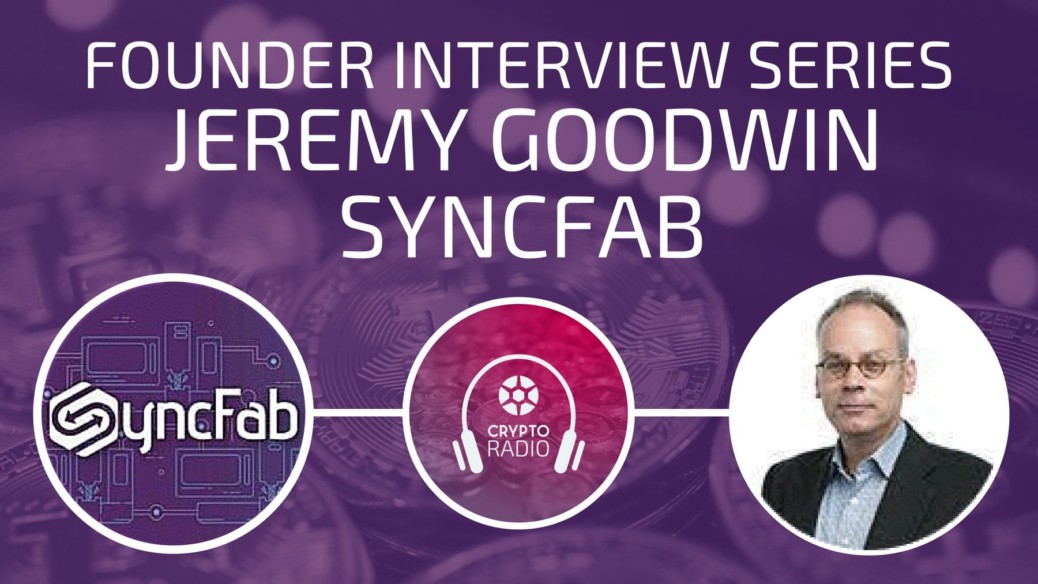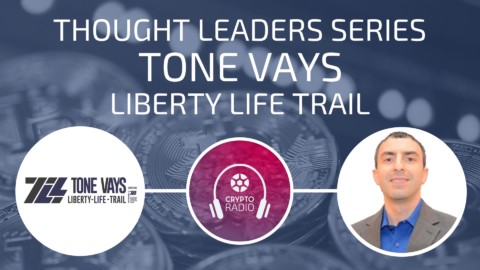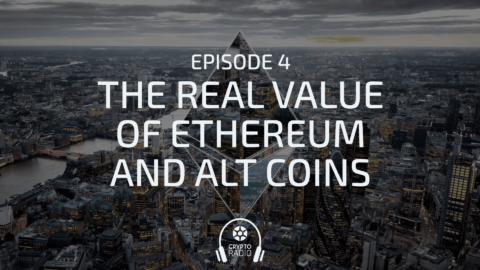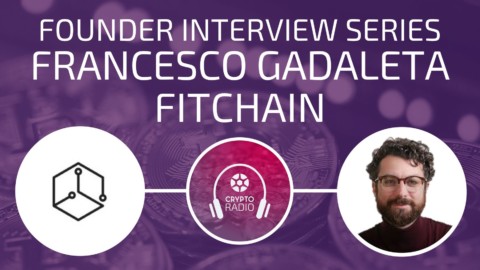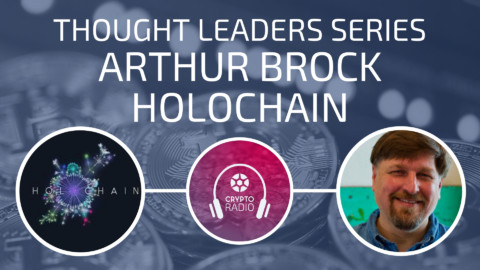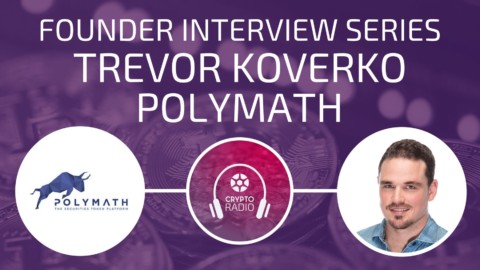Podcast: Play in new window | Download
Chris: What’s up crypto world. Welcome to Crypto Radio. [00:00:30] My name is Christopher Sparks. Today on the show for our founder interview series, Michael and I will interview Jeremy Goodwin of SyncFab. SyncFab is a truly revolutionary approach to streamlining efficiencies in the advanced manufacturing space. Unlike many other supply chain and manufacturing blockchain solutions, which solve very granular problems, SyncFab is a system industry wide solutions protocol that incorporates many facets of the advanced manufacturing process. Let’s let Jeremy give us a glimpse into the future [00:01:00] on manufacturing. Do you have maybe an elevator pitch, so that we can grab the ear of the listening?
Jeremy: We are an Ethereum based blockchain protocol and decentralized application connecting hardware buyers directly to hardware manufactures, peer to peer. Think of us as blockchain smart contracts meet data driven smart manufacturing for smart city economic development initiatives all over. We have launched this token sale to introduce the MFG, the world’s first manufacturing token. [00:01:30] We aim to revolutionize the manufacturing industry with blockchain technology, creating a more response, efficient, and secure supply chain. At the same time, adding a new economy cryptocurrency incentive layer on top of the existing one for manufacturing.
We’re introducing an incentive structure where one currently does not exist, for the manufacturing working class can be more responsive to hardware buyer and inventor requests, large and small, while creating the framework for several new income streams for manufacturers including the maintenance of part lifecycle management documentation on the blockchain. [00:02:00] Which is extremely useful for durable goods brands, like automotive, aerospace, and defence manufacturing.
Michael: So, hey Jeremy. Great to have you on. Before we get into SyncFab and what SyncFab’s about, maybe we could just spend a few minutes talking about you and your background. How you got into the industry you’re in, obviously, with SyncFab but then your background in cryptocurrency, as well. And maybe that transition into getting where you are doing an ICO.
Jeremy: I began originally in operations finance, working with the manufacturing industry on the [00:02:30] ground in China during their industrialisation. So, from when China was the world’s 13th largest economy to where they are now today as the number 2 economy, I was on the ground running around working across the supply channel lines over there evaluating their capacity constraints and what not, and looking at what areas could be financed.
So, having experienced that and speaking Chinese, which I learned in undergrad, I saw the [00:03:00] dramatic change and shift in the industry and global economics that occurred from 2000 pretty much to 2015. After China entered the World Trade organization and hosted the Olympics in 2008. So, fast forward to 2012, when I left my former post as a president and CFO of an [inaudible [00:03:28] traded international [00:03:30] manufacturing company based in Beijing. I decided to start a US based manufacturing supply chain company leveraging new advanced manufacturing technologies that were more conscientious of the environment, of local economics, and really what could be done better in the manufacturing industry.
And with all the advancements in computer design, computer manufacturing, that’s when I started to undertake [00:04:00] the venture with SyncFab. So, I took what I’d gained with my former position, and invested in this new venture SyncFab, which was short for Synchronized Fabrication.
Michael: I guess in terms of blockchain, we’ll come into SyncFab, how SyncFab evolved, where you guys are focusing now. I think you’re in the US market. Are you going to be doing a lot of business with China? I guess from someone outside the manufacturing industry, maybe you can explain to us like how the supply chain works. It’s quite complicated, these different tiers you mentioned, and all the different players and ecosystems, how they interact within a manufacturing sector. [00:04:30] How will blockchain address some of these inefficiencies that you see at the moment?
Jeremy: Yeah. So, traditionally the manufacturing supply chain was, to a great extent, driven by really where to source the lowest cost production for the total landed cost of finalized products before assembly, and then also accounting for assembly costs. While, at the same time, a lot of these international organizations wanted to build new markets for their products at the same time, which was a big driver for [00:05:00] why they were looking to globalize to begin with. So, where that leaves us now is they’ve pretty much already developed a lot of the global markets, and a lot of the global consumers are very well informed now by technology and by their preferences, and by their income. So, they’re a lot more mature.
And they have greater personalized requirements. Because of that, it requires faster time to market more innovative [00:05:30] products to be completed on shorter turnaround times, with higher quality materials that cost better and are more environmentally sensitive. So, what’s happening is it’s requiring a lot more from the supply chain itself so that that old model of simply outsourcing to the lowest production point is becoming less relevant, because of two reasons. One is because of the one that I just mentioned, and the other [00:06:00] is because as advanced manufacturing technology comes online more, it’s becoming more feasible to produce at a more cost competitive rate locally.
And that’s also because of the time cost of opportunity. When you’re sending production away to places that have communication barriers and slower turn around time, it can cost you your position in the market for your product if you don’t get it to market on time. [00:06:30] And so, that being said, you’re having higher material requirements, faster, turn around times, and more customization going into these parts. So, the final deciding factor is going to be the assembly. Now, when Apple says that they cannot make the iPhone in the US because they US doesn’t have the workforce, that’s actually a false statement.
We have a very highly educated, high qualified workforce to design and make the parts that go into the iPhone. What they’re talking about is [00:07:00] primarily the assembly. Assembly workers are not cheap, and automated production processes, at this point, are still limited on the assembly component. And so, that’s an area where it needs to catch up.
Michael: So, in terms of your platform SyncFab, you guys have been running SyncFab now for a couple years and you’re moving obviously to the blockchain as a solution. So, what would you say for someone who’s going to come onto your platform, as a buyer, for example. How are they going to compare two different options, one maybe a local supplier versus someone who’s in China? [00:07:30] How will they make that decision and how will the blockchain support that process?
Jeremy: So, the way our platform works is we have to simplify the process as much as possible. And so, all along it’s been about really how can we streamline the supply chain for the purchase managers. First of all, let me just take manufacturing and dissect it for you very simply. You’ve got primarily three types of manufacturers and customers for the manufacturers. [00:08:00] You’ve got brands you really don’t design or manufacture anything. An example for that might be, say, like a Proctor and Gamble, shampoo, soap, toothpaste, that kind of stuff.
You’ve got designers who have a brand. An example of that could be, say, like an Apple where they will design and engineer their product, they have a big brand but they don’t necessarily manufacture it. And then you have those that are closest to the true types of manufacturer, which is, say, like an auto company. [00:08:30] Auto companies are the closest thing. Auto companies and airplane companies. And even those automobile companies, like a Tesla, even with all their manufacturing prowess and capability, they still have to be supported in many, many ways in terms of outsourcing their manufacturing supply chain.
So, that being said, you have these armies of supply chain purchase managers that work directly inside those companies, as well as outside them supporting them. And they have to source throughout the supply chain. The way they source throughout the supply chain [00:09:00] currently they utilize these types of Stone Age methods where they’re just dispatching these armies of people running around, trying to source from all these different factories physically. Getting on airplanes, driving cars, you know. Plains, trains, and automobiles. As well as phone calls.
In addition to that, once they source the production for these parts and then they’re having everything being assembled, then they have to document the entire process and make sure that it meets all their certification requirements, documentation requirements, [00:09:30] maintenance requirements for the repair people down the line. Or, if they have, say, God forbid, a defence contract, they have to have the security measures in place for the documentation there. There’s various versions of the documentation that goes into that. They’ll have warehouses of filing cabinets across several different years of different types of infrastructure. So, what we do is we created, based on the web 2.0, very intuitively designed [00:10:00] web order flow in partnership with the San Francisco Bay area city of [inaudible [00:10:05], and also as a part of a federal partnership sponsored by the department of energy, department of commerce.
We partnered through their five regional manufacturing centres. So, out the country, south west, the north west, the mid-west, south east and the north east, and looking at another one especially for the Detroit area. And we mapped basically connecting buyers and suppliers for precision manufacturing. [00:10:30] We know how the supply chain first managers work. They already have specifics that they’re looking for. They know what materials they’re looking for, they have specific callouts for finished designs of what they need. So, they’ll give us their designs securely and, based on capacity that we have available in our network according to a specific process for a particular type of material according to specific callouts that this design calls for, in a particular turn around time, we’ll tell them what budgets [00:11:00] are available, which we’ll count.
Based on that and based on the certifications that are required, we’ll let them know what’s available and they’ll make a choice. From there, they can monitor the quality assurance and the quality control online by basically they’ll get a report, an inspection report of all that production before everything is shipped. So, they can inspect it and approve it beforehand. And this entire process that I just explained to you [00:11:30] essentially, it’s already streamlining the supply chain process in the current operating world. But blockchain will optimize that entire flow even greater.
Michael: Maybe in terms of SyncFab specifically and your MFG token, maybe you can just walk us through how a typical person like a brand or a designer or an actual manufacturer, in the automotive space you mentioned those three types of players. How will they come onto your platform and use the token, and how is the value derived for potential people listening to this podcast so they understand this concept better?
Jeremy: [00:12:00] Essentially, the way it’ll work is the MFG token in one scenario where they’re submitting their order requirements, they have their design assets ready and available, they’ll submit their requirements using the MFG token, essentially to get a more rapid response to their requirements. And using the MFG token, it will give them, say, a basket of quotes, anywhere from two to three. And those three suppliers who quote the order, [00:12:30] who quote the job, the winning quoter essentially will get the line share of those tokens. And the ones who do not win the order necessarily, they’ll get a smaller portion but they’ll get something. This is the incentive for them to participate in a greater fashion. So, from the standpoint of an RFQ in the simplest transaction, that’s how it would work Mike.
Michael: That makes sense, and what’s the value for these people then to have the tokens? Let’s say they didn’t win the quote, but now they have some MFG tokens. Can they be recycled back into the [00:13:00] process?
Jeremy: Yeah, so the way we see the token circulating within the manufacturing supply chain ecosystem, within the SyncFab ecosystem, is that it will begin to derive a value of its own. But initially, it’ll be used, yes, one is to initiate the RFQ economy request for quotes. Another is for the buyers to use them for ECRs, which are called engineer change requests. So, that’s after the order is already initiated, and a change request is [00:13:30], which happens all the time, guys, all the time. Those tokens will also need to be used in order to access the same order, and also, again, to incentive the manufacturer to get it online in time. Because a lot goes into this manufacturing process.
On the return side, where the manufacturer can use them is oftentimes when a quote is put out their guys, it’s usually good for a time period for about 30 days. And that’s because the cost of materials, the cost of labour, and the cost of energy and operational costs, they all [00:14:00] fluctuate quickly. So, those quotes you usually only get for a short period of time. At the same time, after a buyer gets the products to their satisfaction, usually what they do is they’re happy and then they’ll sit on it for a couple months, maybe longer. What the manufacturer can do is use those tokens to incentivize the buyer to reorder in a shorter period of time. So, essentially, speed up the reorder process, that’s one way.
Another way is if they want to sweeten, say, a quote, they might sprinkle in [00:14:30] some tokens there to make their quote look a little more competitive. In addition to that, an area that we’re exploring with is that more often than people like to admit, there are bad orders from time to time. And because of that, insurance costs and compensation costs can be tremendous, we foresee the possibility of tokens really playing a part in serving as a portion of that where refunds are required, [00:15:00] or they’re asked for, you know, if it can amount to even five percent of a process then that’s a tremendous value to the manufacturers and the suppliers. And then beyond that, we mention it in the white paper, the manufacturers, they’ll be able to monetize the tokens, as well, in various other ways. Of course, through the exchanges, but that’s not something that we really talk about.
Michael: Just gives everyone an overview of what the token does. You’ve got an ICO coming up, maybe give us a bit of details about that? How much are you looking to raise? What are [00:15:30] you guys going to be using those funds for and maybe your road map in the next couple of years, different partnerships you have in place? What’s basically the future for you guys after this ICO?
Jeremy: The funds raised that we had initially targeted we put together our plan, Ether continues to fluctuate, so we don’t necessarily base it on that. But our original plan was 30 million dollars, at the time Ether was where it was at at 60,000. So, we’ll just say it’s 30 million dollars was our funding plan. And then we had a soft gap of [00:16:00] 15 million dollars. At this point, we also have a minimum, which we’ve already met at this point? Our road map or our milestones, we’ve laid out on our website.
Essentially, the token sale will be integrating the tokens for acceptance into the existing platform, the 2.0 platform, immediately. So, that the token sale will close the end of Q1 2018. The token integration on the platform 2.0 [00:16:30] will begin in Q2 and finish quickly therein. We will begin formatting the smart contracts for the buyers in Q3, and for the manufacturers in Q4. And then beginning in Q1 2019, depending on which cap that we hit, at that point we will begin researching how to upgrade and make the shop floor more compatible with [00:17:00] the envisioned industrial internet of things that we’ve discussed.
So, making the automation compatible manufacturing machine processes more connected with that industrial internet of things, particularly with the SyncFab platform. So, as long as we hit the hard cap, that top cap, we’re looking at that sort of moon shot scenario beginning Q1 2019. In terms of partnerships that we already have in place, as I mentioned before we’re partnered with the city of [00:17:30] San Francisco, the city of San Leandro, and economic development initiatives for their manufacturing industry.
Because of that they’ve been very helpful working with us and we have been very helpful to them in terms of fostering support for their manufacturing community, we’re onboarding their entire manufacturing community – those that are compatible – onto the existing platform. In addition to that, we have federal partnership, department of energy, department of commerce, it’s called CESMI, which is short for the clean energy smart manufacturing [00:18:00] innovation.
And that was recognized by the Obama white house. They reported that on our website, they did a major announcement about that. It’s funded to the tune of 140 million dollars, but that’s spread through a very diverse group of major companies that are also part of that. Including corning blast (?), including Apple, also including [inaudible [00:18:23], a number of other very large manufacturers who all agree that [00:18:30] clean energy and smart manufacturing are the future of advanced manufacturing. And when I speak of smart manufacturing, essentially, it’s a data driven optimized manufacturing.
Michael: Yeah, that’s pretty exciting. And you mentioned you also have a potential proof of concept with Mitsubishi, are you doing any work with Asia in terms of partnership of your road map? Or, is it just a US play for now?
Jeremy: We’re kind of at the eye of the storm, fortunately. With the way the trend is going, with the US positioned to be the number one centre of activity by 2020. But, that being said, [00:19:00] the goal of supply chain really is where we see ourselves integrating in the big data analytics flow as well as the responsiveness of the supply chain, depending on location. So, given my individual background, obviously, and also China’s position is the number two economy and number two market. And the current number one manufacturer as a very important wall. And so, obviously, I mean [inaudible [00:19:25] is the main entranceway for that.
So, a representative of [00:19:30] our international company, Smart MFG Tech, is based in Tokyo and we have a lot of secondary reps on the ground in [inaudible [00:19:36] and all-around China when the time may come. So, we’re constantly taking the pulse, we’re evaluating strategies how to role it out and when we’re going to role it out in China, in Thailand, in Vietnam, as well as in, you know, we’d love to see ourselves being able to enable and help our brothers in Great Britain, as well.
Chris: [00:20:00] Jeremy, could you tell us a little bit about the team that’s working on this? Who’s involved and to what extent, what are their backgrounds, how long have you known each other?
Jeremy: Yeah, certainly. So, the team right now is myself as CEO. There’s my partner, Andy [inaudible [00:20:12]. Andy, interestingly enough, he has a background in information technology and in blockchain. So, he was a big reason why we took the jump into the blockchain component. Originally, Andy was a subordinate of mine [00:20:30] at a telecom venture I was involved in in Hong Kong, in early 2000. So, we’ve known each other for a long time. He’s been talking to me about Bitcoin ever since when it was just a few bucks. He was also an avid gamer, as well. So, we’ve been having that conversation for a long time.
It was really just in early 2017 when we started to see such widespread support and adoption and acceptance of the technology when we realized just the tremendous possibilities [00:21:00] and implications. So, Andy has a really strong background in blockchain, as well as in information technology. He’s also a very successful entrepreneur. He was an early supporter and also worked to help see the company when I was first established in 2013. Andy currently is the chief strategy officer. Our CTO, our chief technology officer, is Jay [inaudible [00:21:24]. He’s really a veteran in coding and programming. He has [00:21:30] become quite adept in blockchain technology and solidity coding, as well, for the Ethereum blockchain.
He’s also fluent in all the traditional programming languages, as well. And he has been our CTO since our founding in 2013. We have our chief design officer, Dennis Delgado, who is one of the younger members of the team but he also brings that real design spritz that we need to keep it exciting. [00:22:00] Working on the user experience and the design flow. So, he spent a lot of time with us on the ground working with the supply chain purchase managers and the manufacturers, and having an industrial design background himself has really helped in the process. It’s because of his real raw talent and us developing him since the beginning that he’s really come up and proven himself. And with this new task that we’re facing on the blockchain side, he’s going to be a tremendous asset [00:22:30] of making it a beautiful and intuitive process for supply chain purchase managers and manufacturers.
In addition to that, we have our marketing officer, VP of marketing, Ben Gerstein. I’ve known Ben for quite a while. He’s also very close with Andy. We also have Victor Nguyen. We have a sizeable and a very capable team. I would suggest that if you want to learn more about the additional members of the team that you just look at the website. One more thing [00:23:00] I might add is we have a very exceptional advisory board, as well. We feel ourselves to be extremely privileged with our current advisory board because we have these eminent folks like Gill Panchina, who was a major early angel investor in eBay and PayPal, also IDG ventures which I believe now is called Blue Ridge Ventures or something like that.
But he’s been able to provide us a lot of insight into really how a lot of this [00:23:30] token sale process works in a way. And he’s been involved in the [inaudible [00:23:35] tech space before it became really shiny and neat and cool through PayPal. As well as Mike Jones with the R Shape Club, and a number of other people. We also have a lawyer on our advisory board. So, in addition to having external legal council for legal opinion that we receive one the transaction, we also have a lawyer on our advisory [00:24:00] board.
As well as a security expert, Michael [inaudible [00:24:06] from MUFG Bank. He manages 200 people under him, security people, managing the security for the Japanese Bank. So, he’s extremely knowledgeable and he’s had ample opportunity to look at a lot of our existing operations, our operation plans for build out. And so, he’s offered a lot of valuable feedback and he’s been quite involved, I think [00:24:30] above and beyond what’s usually expected of an advisory. So, that’s been very helpful and beneficial. Although, our current CTO is extremely knowledgeable and capable on the security side, but it’s always good to have additional feedback from experienced veterans at larger organizations. Especially if we’re aiming for success and to grow and expand ourselves.
We have an iPhone design engineer and manufacturer, Lee [inaudible [00:24:55] from Apple, as an advisor on our team, Chris Chang. [00:25:00] He is an advisor to the company and he offers a lot of valuable insight and input. And also, as I mentioned, we have the CTO of that federal partnership. If there is anybody I left out, I feel bad.
Michael: That’s really useful, actually. Gives us a good picture. So, I think we can wrap this guys, this has been really useful to get insight into your project. Like you said, if anyone has any questions, they can go to syncfab.com. Check out the white paper, find out about the ICO, the public sale is starting soon. So, make sure you’re signed up for that. Anything else you may want to share with our listeners before we end this one up?
Jeremy: [00:25:30] Not just mentioning our social media sights but, of course, if you have questions please do check out our telegram channel, it’s just SyncFab. We’re also on Facebook and LinkedIn and everything else. What I’d like to say is I know manufacturing can be a very intimidating space and it can seem very complicated. Certainly, the descriptions that I just gave, they may not have made it much easier. But I would like to say that [00:26:00] with the computer design technologies that are coming online these days where consumers really are more greatly empowered and they have a lot more opinions that they want to express about what they want to see, in terms of [inaudible [00:26:11] that’s available in the stores.
This is really what a lot of manufacturers are looking to capitalize and to move on, and these computer design technologies and 3D printing are making the average consumer and the average Joe a lot more empowered. So, because of these new technologies, all of you really are [00:26:30] good candidates, eligible candidates for the MFG token, because what we’re looking to do is to revolutionize the manufacturing industry with the MFG token by creating these new income streams to those working-class workers and to the blue-collar workers. Creating new income streams for them, giving them a reason to be more responsive so that they can create more competitive, rapid response supply chains.
So, whether or not you have an opinion about a design and a product that you want to see, whether or not you’re a designer, an engineer, an inventor, [00:27:00] as long as you want to support the revolution of the manufacturing industry, and you want to support the creation of this new economy and manufacturing industry, you are a good candidate for the MFG token.
Chris; That’s a really good motivator for anybody who has any concern for the health of the planet and the future. So, that’s a pretty good reason to buy the MFG token. Thank you very much, Jeremy, for coming on to our founder’s series. If anybody has any more questions, Jeremy’s left you with plenty of contact details. Their website is blockchain.syncfab.com. [00:27:30] See you next time.
Jeremy Goodwin explains how SyncFab platform uses blockchain technology to directly connect hardware manufacturers with buyers in the manufacturing supply chain.
SyncFab was founded in 2013, after Jeremy Goodwin spent 4 years as the CFO of a Chinese manufacturing company, where he gained deep insights into the problems of manufacturing industry and supply chain management.
Jeremy describes SyncFab as a peer-to-peer, Industrial Internet of Things (IIoT) manufacturing blockchain. He explains the current problems that small hardware manufacturers in particular face when trying to reach their buyers, and gives a detailed overview of a simplified process that this new platform aims for. SyncFab (Synchronized Fabrication) proposes ways to eliminate intermediaries and marketing costs by using blockchain to directly connect buyers with hardware manufacturers. The platform should speed up ordering and improve production tracking and pricing, and create new income streams for working class and blue collar workers.
Jeremy also introduces the team and explains how people who don’t have any experience in manufacturing industry can benefit from this platform. SyncFab has already established a number of private-public partnerships on a local and federal level to help innovate the automotive, aerospace and defense industry. They are looking to raise a total of $30M USD.
MFG Token
MFG Token is designed to incentivize sellers to speed up the sending of quotes and executing orders, and buyers to answer faster to a vendor’s bid or place another order in a preset timeframe.
SyncFab has launched the MFG Token public sale on February 15, which will run until March 15 2018 or until the hard cap is reached.
Resources
- SyncFab Website
- SyncFab Token Sale Website
- SyncFab White Paper
- Connect with SyncFab on Telegram
- Crypto Radio’s Founder Interviews Series
This episode is hosted by:

